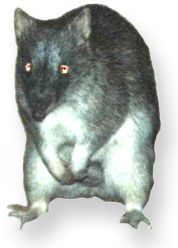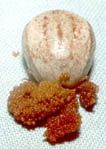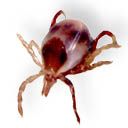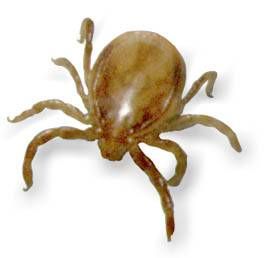LIFE CYCLE of Ixodes holocyclus
General features of the life
cycle
Geographic distribution
Climatic disposition
Botanical disposition
Hosts
Predators
Ecological role
Life cycle facts and figures
General features of the life cycle
The life cycle is comprised of four stages- egg, larva, nymph, adult. Larvae have 3 pairs of legs and the nymphs and adults 4 pairs. Ixodes holocyclus is a three-host tick. To moult to the next stage a blood meal must be obtained by the larval or nymphal tick. Moulting is known as ecdysis. The process of seeking a host is known as "questing" - each tick climbs to the top of nearest vegetation and extends or waves its forelegs to and fro in order to make contact with a prospective passing host. Certain biochemicals such as carbon dioxide (hence the use of "dry ice" baits) as well as heat and movement serve as stimuli for questing behavior. See UC Davis website for picture of a questing tick. Both female and male ticks quest for a host, but for different reasons; the female for a bloodmeal, the male to search the host for a female tick in order to mate and feed from her. Males may parasitise the female ticks by piercing their cuticle with their mouth parts to feed on the haemolymph (up to 3-4 males have been found feeding on one female tick). Adult male ticks rarely blood-feed on a host. The outside surface, or cuticle, of hard ticks actually grows to accommodate the large volume of blood ingested, which, in adult ticks, may be anywhere from 200-600 times their unfed body weight (Sonenshine, 1991). When a tick is fully engorged it is said to be "replete".
Geographic distribution
According to Kelly (1977) Ixodes holocyclus is found in Australia, New Guinea, Indonesia and India. Latest sources, however, suggest that the species is confined to the East Coast of the Australian mainland. See also the more detailed page Distribution of Ixodes holocyclus.
Climatic disposition
Humid conditions are essential for survival of the paralysis tick. Dry conditions, relatively high temperatures (32 °C) and low temperatures (7 °C) are lethal for all stages after a few days. An ambient temperature of 27 °C and high relative humidity is thought to be optimal for rapid development (Clunies-Ross, 1935). Very dry or very wet conditions are not ideal.
The tick population in a given year is probably governed by the rainfall in the previous year if the temperature variations have only been moderate. Northeasterly weather, with moisture laden sea breezes on the east coast of the continent provide ideal conditions. This pattern usually sets in during the Spring and early Summer and tick infestations are most common during this period. Typically, larvae late Feb to April-May, followed by nymphs to Sept-Oct and then gradually the adult adult population increasing to a peak around December. Under favourable conditions a second cycle may result in a second peak in May. However, infestation by adults can occur at any time of the year when conditions are suitable, even in mid winter. In fact it is only in the very hot summer months that they are difficult to find.
Botanical disposition
The need for humid conditions largely determines the botanical niche of Australian paralysis ticks. Low, leafy vegetation provides higher humidity levels by reducing the desiccating effects of wind and direct sunlight. This environment also suits the tick's major host, the bandicoot, as it seeks out grubs and worms in the leaf litter.
Apparently, there is a worldwide folklore about whether ticks climb and jump from trees. This debate probably arises because ticks are often found on human heads- but one should take into account the fact that they do not necessarily start there, for they are known to walk over the host until they find a suitable place. They can also latch onto heads when people stoop under leafy branches.
Unfortunately, little is known about the migratory habits of the Australian paralysis tick. Based on the behaviour of comparable ticks in other countries they probably would not climb very high up the vegetation. For example the greatest height so far recorded belongs to the larval stages of Ixodes scapularis in the USA, which have been found to ascend to a height of only 2 metres (Matthew Shaw email, pers com).
However, at the National Tick Paralysis Forum III (Sydney 2002, hosted by Merial Aust) two leading experts in the field of tick collection in Australia (Bill Conroy and Neil Warne) gave assurances that paralysis ticks DO infact climb trees. In fact nymphs and adults climb many meters to the very tops, but descend in windy or dry weather. Larvae would appear to remain closer to ground.
Hosts
 Officially, it seems that
any warm-blooded animal (ie bird or mammal) is a potential host for the Australian
paralysis tick. Whilst its occurrence on reptiles has been generally omitted
from official texts, this runs counter to some observations where the paralysis
tick has apparently been found on blue tongue lizards and geckos- see Hosts.
Officially, it seems that
any warm-blooded animal (ie bird or mammal) is a potential host for the Australian
paralysis tick. Whilst its occurrence on reptiles has been generally omitted
from official texts, this runs counter to some observations where the paralysis
tick has apparently been found on blue tongue lizards and geckos- see Hosts.
The so-called 'natural' hosts include the long nosed bandicoot (Parameles nasuta), the giant brindle bandicoot (Isoodon torosus), the possums and the echidnas but there are many others (see the page on Hosts). As the most common natural host the bandicoot can carry large numbers of engorging females (up to 62) without any apparent ill effects. Taken into captivity however, bandicoots lose the natural exposure conditions that give them immunity (see immunity).
Most mammals such as calves, sheep, goats, foals, pigs, cats, cavies, rats, mice and man are infested by the tick. Fatalities resulting from a single engorged adult female tick are mostly reported in the young animals of the larger species. Larvae and nymphs can also produce toxic reactions in the host. Fifty larvae or five nymphs will kill a 40 g rat, larger numbers of either can induce paralysis in dogs and cats. One adult female can kill four different susceptible rats during engorgement. Although it is not typical, an engorging adult female apparently can reattach several times to different dogs (Jones, 1991, Warne, 2002).
Predators
Wasps are apparently amongst the predators of the paralysis tick (Conroy, 1999). Factors which affect the numbers of wasps may therefore also affect tick numbers. Presumably insectivirous birds would also be predators?
Ecological Role
The web author [NF] has not seen information published on this subject so far. It may be asked, does the paralysis tick benefit any other species of fauna? Could predators such as the dingo (tiger quoll???) have had their numbers limited by tick poisoning? - might this in turn may have benefitted the other small marsupials that are perhaps more ideal hosts. In the modern context, might tick poisoning be controlling numbers of feral animals such as feral dogs, cats and pigs? I must emphasise that this is speculation on the part of the web author.
Life cycle facts and figures
The total minimum life cycle is 4.5 months (135 days) and the maximum 14 months (437 days). Under laboratory conditions, female ticks have been kept alive for more than two years. On average it will take approximately a year to complete, but it is very much dependent on climatic conditions.
ADULT |
|---|
When fully engorged [replete], the adult female drops off the host, and after 11-20 days starts to lay a batch of 2,000 to 6,000 eggs into moist vegetation over 16-34 days, and then it dies. Female body dimesions vary from 2.6 x 1.1 mm to 3.8 x 2.6 mm (unfed) up to 13.2 x 10.2 mm (engorged). |
EGG |
On the ground, suitable warmth and high humidity required for development (eg moist leaf litter). The eggs can survive the winter. The egg hatches on the ground after a 49-110 day incubation. |
LARVA |
The hatched larva, known as a "seed tick", undergoes 7-44 days of "hardening" and then climbs vegetation (eg the tips of of leaves). It attaches to a passing host (the 1st), feeds for 4-6 days then drops to ground; over a further 19-41 day period it then moults to a nymph. The overall period in the larval stage (hatch to moult) is temperature dependent. It may, for example, take 20 days at 27.5 ° C and 40 days at room temperature (21 °C) but may extend to 36 weeks. Larvae are just visible to the naked eye, body dimensions 0.5 x 0.4 mm (unfed) to 1.15 x 1.0 mm (engorged). |
NYMPH |
Nymphs are very active and 5-6 days after moulting and readily attach to another host (the 2nd) after day 7-8 (up to 31 days). The nymph feeds for 4-7 days, then drops to the groundAdults . After a further 3-11 weeks the nymph moults to become the adult male or female. Again the period is temperature dependent. may emerge from the nymphal stage from the 20 days at 24-27 °C to 53-65 days at 10-21 °C. Dry conditions also prolong this period and can actually kill nymph. Nymph body dimensions are 1.2 x 0.85 mm (unfed) to 3.5 x 2.5 mm. (engorged); |
ADULT |
The newly moulted adult female becomes increasingly active for the 1st 6-7 days. It seeks and attaches to yet another host (the 3rd) after 7-9 to 77 days. It engorges for a period of 6-30 days, the time being dependent on weather- slower when cold. Male ticks do not usually engorge rather they wander over the host feeding "attach" intermittently and searching for unfertilised females. |
Female engorgement
An adult female can be attached for up to 30 days (these figures being derived from laboratory culture colonies). Under natural conditions, the time taken for an adult female to engorge while on the host varies from 6 to 21 days, the period being longest in cool weather. Thus a dog may carry a tick for up to three weeks without the tick being significantly engorged or causing paralysis. However in warm weather the female engorges rapidly, and at the same time, injects her toxin into the host thus causing paralysis if the host is susceptible. The adult female does not inject detectable amounts of toxin until the 3rd (some authors say 4th) day of attachment to the host, with peak amounts being injected on days 5 and 6. Once the tick detaches and it has waited 11-20 days, it starts to lay 20-200 eggs per day over 16-34 days, and dies 1-2 days after egg laying is complete.
The male
The adult male, after crawling on to the host does not attach or feed on blood, but spends its time wandering around on the host looking for a female with which it can mate. The adult male is yellowish-brown, flat, oval, and smaller than the female. The male dies after fertilising the female although some males can endure for longer if they parasitise the engorging female)
Survival times
Unfed larvae may survive for 162 days, unfed nymphs for 275 days and females for up to 77 days.
Bibliography
John D Kelly, Veterinary Review No 17 Canine Parasitology, published by The University of Sydney Post-graduate Foundation in Veterinary Science, NSW, 1977.
Jones, Davis K, Proceedings of the Post Graduate Committee in Veterinary Science, University of Sydney No 149: Emergency Medicine and Critical Care, Tick Paralysis, 1991.
National Tick Paralysis Forum (1999) Tick Poisoning in Dogs and Cats. Merial Australia Ltd. Bulletin No. 1
The Paralysis Tick of Australia - Home
E-mail Us to report a broken link!





